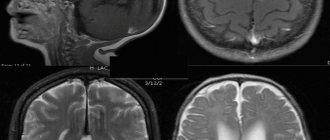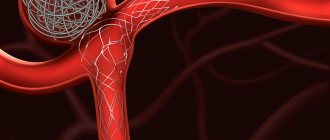Cerebral ischemia is characterized by partial blockage and narrowing of blood vessels in the head, most often due to atherosclerotic deposits. Damaged vessels are not able to pass a normal volume of blood, so the brain tissue does not receive the required amount of oxygen and nutrients. Over time, a person notices memory loss, deterioration in performance, sleep problems against the background of chronic fatigue. These alarming symptoms should be a reason to visit a qualified physician. Otherwise, the patient may risk stroke, memory loss and disability.
How does cerebral ischemia occur?
Cerebral vascular ischemia is mainly an age-related phenomenon. The normal functioning of blood vessels ensures that all organs are supplied with a sufficient volume of blood. With age, the elasticity of the vascular walls deteriorates; they become overgrown with accumulations of cholesterol plaques. The greatest danger is caused by damage to large arteries.
The vessels of the head are especially sensitive to these deteriorations, because a fifth of all blood in the body passes through them. The human brain cannot function properly without a constant flow of oxygen and nutrients that the blood contains. A decrease in their volume invariably leads to the degradation of brain tissue, the death of neurons and the loss of some functions, often vital.
Ischemic processes in the brain can also be provoked by changes in the properties and composition of the blood (in particular, increased clotting) due to kidney disease, thyroid dysfunction, and metabolic disorders. Problems with the heart and toxic poisoning can also reduce the activity of blood flow in the vessels of the head. Now you can undergo a consultation and a set of preparatory examinations when registering for a course of enhanced external counterpulsation or shock wave therapy of the heart absolutely free of charge!
Promotion
Just until the end of autumn, undergo a free consultation and a set of preparatory examinations* when registering for a course of enhanced external counterpulsation or shock wave therapy of the heart.**
Send a request
* Check the details of the Promotion by phone. **Has contraindications; consultation with a doctor is required.
Enhanced external counterpulsation (EECP) Cardiac shock wave therapy (SWTS)
Hurry up to apply, the promotion period is limited.
Development mechanism and reasons
There are at least four known processes that could be called cerebrovascular insufficiency. The pathogenesis, accordingly, is somewhat different.
The main option is atherosclerosis. This is a narrowing or, more often, blockage of the arteries with cholesterol plaques.
In the first case, the condition is transient, the stenosis recedes on its own. Not counting critical situations. Thus, in experienced smokers, spasm of the vascular muscles can last indefinitely.
The main danger here is the likelihood of spontaneous development of a stroke, acute neurosis of nerve clusters.
As for cholesterol plaques, they arise against the background of metabolic (metabolic) problems. Normally, lipids (fatty compounds) are eliminated from the body naturally. Only a small part of fats is absorbed due to enzymatic reactions.
If there is a metabolic disorder, the degree of absorption (absorption) will be higher, and accordingly more harmful compounds penetrate into the blood. In the short term, this leads to plaque growth. It blocks the blood flow.
The second option is thrombosis. Partial blockage of the lumen of a vessel with a blood clot. This formation of shaped cells is not always related to the brain. The original source can be anywhere. Most often these are the blood supply structures of the lower extremities.
The third possible situation concerns arteritis. Inflammation of the endothelial layer or lining of blood vessels. It develops as a complication of infections or an autoimmune process within systemic pathologies.
Finally, vascular malformations or aneurysms are also often found. The first are abnormal areas of communication between arteries and veins, the second are protrusions of the walls of a saccular or diffuse nature (along the entire diameter in a certain place).
What do the described pathologies have in common?
Despite the difference in the essence of the deviation, the disorders have one thing in common: the occurrence of a mechanical obstacle to the blood flow. Insufficient liquid tissue reaches the nerve clusters.
On the other hand, the body intensifies the work of the heart in order to compensate. And this is the path to increased blood pressure.
Thus, the risk of not only acute ischemia, when tissues lack trophism, increases, but also hemorrhage - rupture of a vessel from excessive stress, which is much more dangerous.
Attention:
All described conditions without treatment are fraught with acute cerebral insufficiency, which diagnostically corresponds to a stroke.
Causes of the disease
Atherosclerosis and arterial hypertension are two causes that account for the vast majority of cases of cerebral vascular ischemia. Cholesterol is especially actively deposited on the walls of blood vessels in people over 40 years of age. It is at this age that the risk of ischemic events increases. If the patient does not adjust his lifestyle, the growth of cholesterol deposits only progresses and leads to a deterioration in brain function.
The second most common cause is chronic heart failure. If the heart does not produce enough blood, this automatically disrupts the nutrition of the brain. Also, symptoms of ischemia often appear in patients with various types of arrhythmia, since disruption of blood flow dynamics negatively affects the blood supply to the brain.
Other reasons include:
- hereditary angiopathy;
- kidney disease;
- blood diseases;
- diabetes;
- metabolic disorders;
- endocrine diseases;
- systemic vasculitis.
Deformations and abnormalities of the blood vessels of the neck, aorta and other large arteries can cause deterioration in blood flow to the brain. These can be either purely vascular diseases (for example, aneurysms), or damage, compression of blood vessels by neighboring tissues and structures (vertebrae with osteochondrosis, tumors).
Intracranial hypertension
Cerebrovascular disease is considered a collective term that covers various diseases that lead to impaired cerebral circulation. Such diseases can occur in both acute and chronic forms and belong to the class of cerebrovascular disorders. Intracranial hypertension is characterized by abnormally high intracranial pressure. Chronic intracranial hypertension most often refers to the idiopathic form of the disease; the cause of the development of the disorder remains unclear. Intracranial hypertension is common, often in people with neurological diseases.
Intracranial hypertension leads to impaired cerebral circulation and provokes the formation of secondary cerebral ischemia. Cerebrovascular diseases become the cause that leads to the development of intracranial hypertension. Increased intracranial pressure can lead to coma, sensory disturbances, speech disorders and other severe disorders. Intracranial hypertension is a severe complication of brain diseases.
Symptoms of cerebral ischemia
The disease is quite insidious and in the early stages it can manifest itself with symptoms that a person barely pays attention to or does not associate them with brain activity. For example, loss of attention, sudden mood swings, sleep disturbances (insomnia or, conversely, drowsiness). Most often, these signs are attributed to work fatigue.
However, later the symptoms become obvious and disrupt the usual rhythm of a person’s life.
- Dizziness, nausea.
- Headaches of varying severity.
- Forgetfulness.
- Feeling of coldness in the feet and palms.
- Numbness of the limbs.
If action is not taken at this stage to eliminate the symptoms using medicine, the disease will progress rapidly. Further signs can no longer be ignored.
- Temporary loss of vision (partial or complete).
- Problems with speech (incoherence, slurring).
- Headaches to the point of vomiting.
- Insomnia.
- Memory losses.
- Movement disorders when walking.
- Disorientation in time and space.
The situation becomes extremely dangerous, since with these symptoms the patient is only one step away from a stroke.
Stages
The pathological process is staged based on the quality of nutrition and, on the other hand, the degree of deviation of trophism from the normal level.
It is customary to call 3 stages of cerebral blood supply insufficiency:
- Stage 1. Initial or compensated. It develops spontaneously, as a result of the influence of a negative factor - stenosis or blockage (mechanical obstruction to blood flow).
The patient does not experience significant discomfort, and is often unaware of his own condition, so he is in no hurry to see a doctor.
Initial manifestations, such as slight lethargy and decreased speed of thinking, occur sporadically. Such manifestations are attributed to prolonged lack of rest and overwork. Newfangled chronic fatigue syndrome that doesn't actually exist.
The duration of the phase varies from several months to 5-7 years. A person can remain in this state for a long time; the timing of progression depends on the individual characteristics of the body.
- Stage 2. Subcompensation or clinical manifestations. An initial neurological deficit occurs. The patient is accompanied by headaches and nausea. The productivity of mental activity decreases. A person cannot solve logical problems that previously did not present difficulties.
Intelligence is formally preserved, but the conductivity of the nerve impulse is reduced. Specific behavioral tests reveal violations of the emotional-volitional plan.
The person is weak, drowsy, moves little, prefers to limit social contacts. Autism is growing. Not always, but it is possible.
It is necessary to carry out a differential diagnosis with schizophrenia spectrum disorders.
- Stage 3. Decompensation or neurological deficit. The patient becomes demented. Signs of vascular dementia are increasing. Pronounced pseudoparkinsonian phenomena are detected: dizziness, tremor, unsteadiness of gait.
These are extrapyramidal disorders. There is also fecal and urinary incontinence, a general decrease in intelligence, emotional and volitional disorders such as apathy, abulia (which again requires differential diagnosis and schizophrenia).
Attention:
We are talking only about chronic cerebrovascular insufficiency. Acute is not divided into stages; it occurs suddenly and is accompanied by a complete clinical picture. Most often, clinically it corresponds to a stroke.
Diagnosis of cerebral vascular ischemia
The most important examination method for these symptoms is ultrasound of cerebral vessels. The “gold standard” is duplex scanning of the brachiocephalic arteries, which effectively detects disturbances in the functionality and structure of blood vessels.
An objective picture of the disease is also presented by ultrasound transcranial Dopplerography of cerebral vessels. The study shows the speed of blood flow, the degree of damage to the vascular walls, etc.
These examinations are carried out by the Center for Pathology of the Circulatory Organs of the CBCP. For this purpose, the latest expert-class equipment is used.
Degrees of cerebral vascular ischemia
In medicine, it is customary to classify this pathology into three degrees. The most difficult is cerebral ischemia of the 3rd degree.
1st degree . Characterized by mild disorders of attention and intellectual activity. Most often, patients cope with complex tasks, but it takes them longer. There are no obvious limitations in life activity or coordination disorders yet, but minor signs of the disorder are already noticeable:
- shuffling gait;
- pain and numbness in the hands after physical activity;
- irritability;
- frequent weakness.
2nd degree . In some cases, the patient has little control over his actions. When performing work tasks, he often needs help and hints, which negatively affects his professional activities. The person may also lose some life skills. Increasingly, he is tormented by general ailments with the characteristic symptoms described above.
3rd degree . Pronounced neurological disorders appear in the form of Parkinson's disease, urinary incontinence, and problems with coordination. The patient may lose the ability to move independently, as he has poor control of his legs and loses the ability to navigate in space. There are disturbances in thinking, memory, and speech. In the absence of medical care, a patient with grade 3 ischemia will face complete personality collapse, ischemic stroke, and cerebral hemorrhage.
Chronic cerebral ischemia
Symptoms of chronic cerebral ischemia develop gradually, but with noticeable manifestations. They are often associated with cardiac dysfunction, angina pectoris, arrhythmia, diabetes mellitus, atherosclerosis of peripheral arteries, and other diseases.
Most often, cerebral ischemia becomes chronic in cases of 2nd degree disease. This type of disease is characterized by long-term development without any complications. However, this does not mean that the disease does not progress. Usually, deterioration in health occurs unexpectedly. And any nervous or physical stress can provoke it.
Chronic ischemia does not require mandatory hospitalization.
Treatment of cerebral vascular ischemia
The patient is prescribed complex treatment, which includes:
- massage and physiotherapeutic procedures to improve blood circulation;
- hypoxic therapy to saturate tissues with oxygen;
- drug therapy to normalize blood pressure and restore blood circulation;
- surgical intervention to remove atherosclerotic plaques from blood vessels.
Treatment of chronic cerebral ischemia is combined with therapy for other organs and systems.
Treatment
The point is to eliminate the root cause. For atherosclerosis, statins are prescribed. Atoris as the main one. They remove cholesterol and dissolve existing cholesterol plaques.
Antiaggregants allow you to restore blood fluidity and prevent the formation of blood clots and clots that can block blood vessels. Aspirin, Heparin.
Anti-inflammatory, glucocorticoid drugs (Prednisolone, Dexamatezone and others), if necessary, antibiotics to eliminate arteritis and vasculitis. Lesions of the internal lining of blood vessels.
In fact, cerebrovascular agents and protectors are used to correct cerebral blood flow. Piracetam, Actovegin, nootropics like Glycine and others.
Operations are required in extreme cases, for example, if there is malformation, aneurysms, advanced atherosclerosis with plaque hardening. The question of the appropriateness of therapy is decided at the discretion of the specialist.
Lifestyle changes do not play a big role. It is enough to give up smoking and alcohol, minimize the amount of fatty foods and everything will fall into place. Adequate physical activity will not be superfluous.
Treatment of cerebrovascular insufficiency of the brain is medicinal, less often surgical, according to indications.
Prognosis and prevention
The consequences of cerebral vascular ischemia can be minimized if you consult a qualified doctor in a timely manner. This should be done when symptoms of the 1st degree of complexity appear. At this stage, preventive actions are sufficient:
- maintaining physical activity;
- nutrition correction;
- abstaining from nervous stress.
Even with symptoms of the 2nd degree of severity, the prognosis is positive, provided the patient follows all the doctor’s prescriptions. Seeking help at the 3rd stage of the disease is in most cases ineffective.
Forecast
Depends on the root cause. At the initial two stages - favorable. It is possible to completely reverse the process, restore cognitive functions and higher nervous activity in general.
When adding deviations of consciousness, gross deficits (behavioral disorders, mental disability), the likelihood of cure is already low. But there is still a chance to take control of the process.
However, it is recommended to consult a doctor at the very first stages when suspicious symptoms arise.









